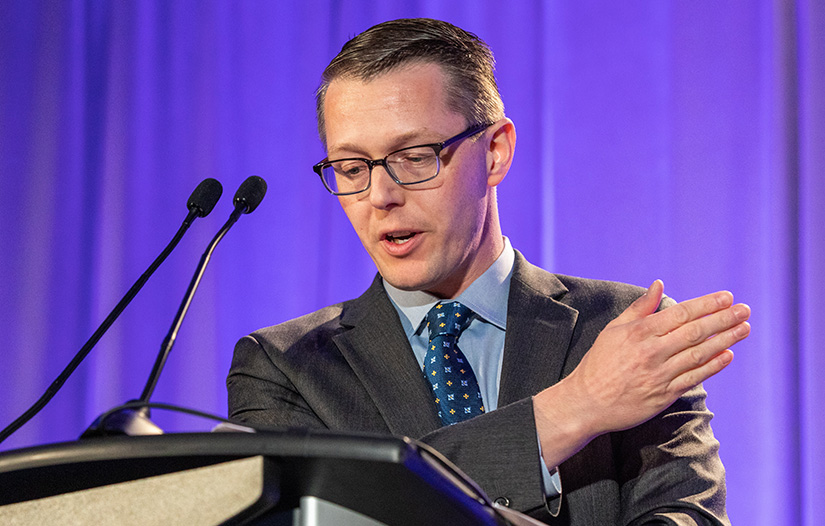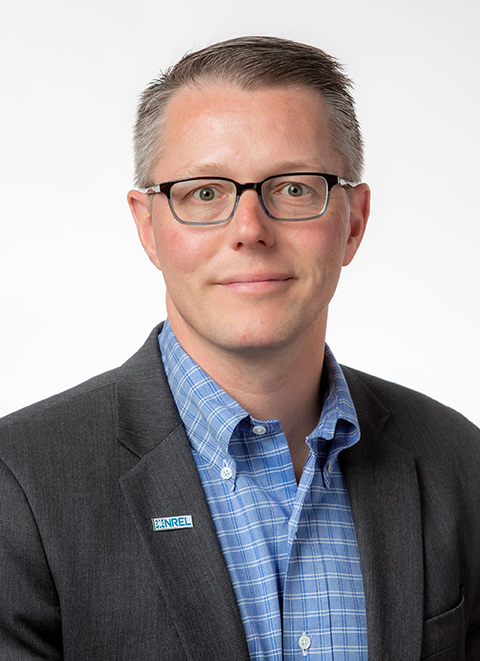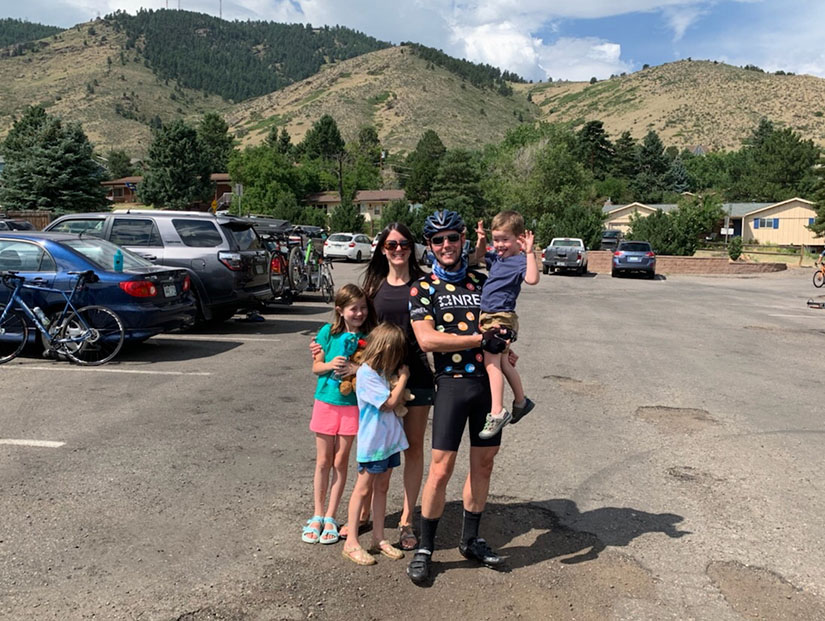Star Tech: Eric Payne on Joy of Taking an Idea, Getting a Patent, and Helping Create a Company

Senior Licensing Executive Eric Payne identifies as a scientist even though he typically does not spend his time in a lab. “I still am a scientist,” Payne said.
However, along the way to his current role at the National Renewable Energy Laboratory (NREL), the 44-year-old has added some other hyphenated titles: inventor, patent agent, cyclist, husband, and father of three.
The initial seeds for science actually came from a love of science fiction.
Although neither of his parents were scientists, watching "Star Trek: The Next Generation" was a family ritual, he recalled. Once, 11-year-old Payne convinced his parents to drive him from their home in rural central Indiana to attend a Star Trek convention in Chicago. He even met his hero, actor Patrick Stewart, who played the daring Captain Jean-Luc Picard. Carl Sagan’s "Cosmos" was also regular TV fare.
And while he tends to downplay some of his boyhood background, Payne learned the ethic of hard work by spending summers on his family’s farm. He also absorbed an appreciation for solving problems, rising early, and long days, clearly inheriting a strong work ethic.
“I wake up at 5 a.m. every day. I can’t break the habit,” he said. “It drives my family nuts.”
Despite his love of sci fi, actual science—not movies—were Payne’s passion.
While an undergrad at Purdue University, he studied genetics and microbiology. But it was his exposure to everyday science that really shaped his future. To pay for college, he worked in scientific research labs, cleaning glassware, replacing pipet tips, and conducting polymerase chain reaction (PCR) work.
“Purdue was a great place,” Payne said. “They let you play with expensive instruments and learn the scientific method.”
Armed with that knowledge after graduation in 2003, he joined the Centers for Disease Control (CDC) in Atlanta as part of the Emerging Infectious Disease Center. It was there that Eric really began on the path that carried him to NREL.
While performing what is called gas chromatography tandem mass spectrometry, a process to detect bacterial pathogens in minute quantities, he invented a new technique.
“I submitted this idea to the CDC’s Tech Transfer Office,” he said. While the CDC liked his concept, they admitted they did not have anybody on staff who understood what he had done. Instead, his bosses encouraged him to volunteer with a patent attorney and then file a patent application.
“That’s exactly what I did,” he said. “I got to see how challenging it was to write a patent application and license the technology out.”
The experience provided insights that help him to this day.
“It gave me a deep appreciation for every scientist at NREL who has developed an innovative idea. I feel their struggle. It is personal to me," Payne said. "As an inventor, I know the feeling: ‘Where the heck do I start? You want me to write a patent application and commercialize my invention? I can’t do that.’”
Eventually, a company licensed his idea, and for a while Payne received royalties. “Not enough to take my wife to dinner, except maybe to Subway,” he joked.
Still, intrigued by this difficult process, he decided to learn more about patent law. Payne volunteered at a law office in return for mentoring. He focused on several dense chapters on patent law, memorizing the content so well that he passed the U.S. Patent and Trademark Office patent bar exam on his first try to become a patent agent, privy to the mysterious world of patent law.
After a stop from 2005 to 2009 as technology manager at the University of Illinois’ Office of Technology Management—a stint that included meeting his future wife, Lesley—Payne joined NREL’s Tech Transfer Office in 2009.

Payne began with a focus on negotiating complex intellectual property transactions. He summed up his work succinctly: “My purpose here at the laboratory is to protect new innovations and accelerate the adoption of those in the market.”
Easier said than done, however.
“When I came here, our systems for doing that were pretty underdeveloped, frankly. We were receiving about 20–30 new inventions every year,” he said. “This past year, we brought in almost 300.” Of course, he acknowledged that the laboratory has grown during his 15 years. Nevertheless, he believes things have progressed. “I take great pride in knowing that we’ve made it easy for researchers to reach out to our office,” Payne said.
When researchers do reach out, it is likely that they will cross paths with Payne at some point. And nobody is more excited than he is by that prospect—which is why he was honored in NREL’s first cohort of Distinguished Operations professionals.
His field is tricky. Commercializing early-stage technologies is not easy, because it requires domain expertise in science, business, and law.
Payne bridges the gaps along the way to maximize the impact of researchers’ scientific innovations. He speaks from hard-won experience, but the journey is part of the reward.
“I get such pleasure out of helping NREL researchers navigate this really complicated process,” he said.
Although he has been involved in countless such undertakings, the novelty does not wear off. “I remember sitting down with Gregg Beckham and looking at his invention, which was an exciting concept on paper,” Payne said.
Over time, they collaborated with NREL’s Office of General Counsel to file a patent application and then do some development and exploration work to find commercial entities willing to bring products to market. Eventually, Beckham’s idea for a new technology was licensed to a company.

“Now that company employs a dozen people doing the heavy lifting of commercialization. These folks have jobs, they can take care of their families, take their kids to soccer practice, all because of the nascent idea that somebody as brilliant as Gregg had,” Payne said. “I was a small part of that. When a promising early-stage technology is commercialized—it’s magic.”
The magic is being recognized. At NREL’s recent Fiscal Year 2023 Staff Awards and Technology Transfer Awards ceremony, Beckham was given the Outstanding License award for a renewable nitrilation technology that represents a novel route to produce low-carbon bioproducts with startup Mars Materials.
In his Distinguished Member of Operations Staff letter of recommendation, Beckham wrote that Payne “is an amazing colleague who makes working at NREL worthwhile and meaningful. I have simply never met another individual like Eric—he is an absolute force of nature.”
Technology Transfer Director Anne Miller added, “We have been very fortunate to have Eric on our team. He has been a source of exceptional licensing expertise for NREL—and beyond.”
Miller noted that Payne is often sought out by his peers within the U.S. Department of Energy (DOE) network of laboratories for guidance. “I believe that there are few, if any, other licensing professionals in the DOE system who could navigate complex transactions with the level of skill he achieves,” Miller said.
The admiration is mutual.
“I am so lucky to have found tech transfer,” Payne said. “It is such a great field. Tech transfer allows me to stay on top of the science while helping researchers be their best. It tickles me to death.”
Payne is also in the perfect spot, because the field requires a deep understanding of patent law and business. “I like how it combines all three,” he said.

Payne lives his passions at home too. He and his wife Lesley are encouraging their three children to engage in science and to participate on a robotics team. And, as an avid bicyclist who often rides the eight miles from home to the laboratory, he has also gotten the family involved in cycling.
Throughout it all, Payne still expresses amazement in a process that can turn words on a piece of paper into a thriving enterprise. “What makes me really happy is that we’ve increased by orders of magnitude the uptake of NREL technologies into the private sector,” he concluded.
But most of all, this enthusiastic multi-titled hyphenate finds joy in his job.
“My entry was hands on. I was an inventor who struggled to convey what my innovation was,” Payne said. “Then I helped to get it commercialized. That was not an easy road. Now I get to help other inventors here at NREL do that.”
It never gets old.
“I feel like a kid in the candy store whenever I get to meet up with one of the scientists here,” he said.
Truly, Payne is a star tech; the next generation is unfolding.
Last Updated May 28, 2025
